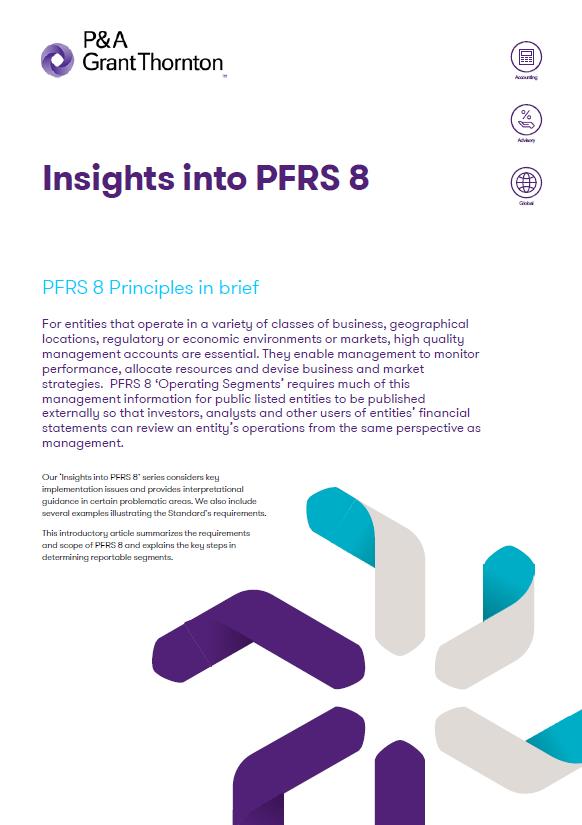This Accounting Alert is issued to provide an overview of the requirements and scope of Philippine Financial Reporting Standards (PFRS) 8, Operating segments, and explain key steps in determining reportable segments.
Overview
For entities that operate in a variety of classes of business, geographical locations, regulatory or economic environments or markets, high quality management accounts are essential. They enable management to monitor performance, allocate resources and devise business and market strategies. PFRS 8, 'Operating Segments’ requires much of this management information for public listed entities to be published externally so that investors, analysts, and other users of entities’ financial statements can review an entity’s operations from the same perspective as management.
The "Insights into PFRS 8" series considers key implementation issues and provides interpretational guidance in certain problematic areas. This introductory Accounting Alert summarizes the requirements and scope of PFRS 8 and explains the key steps in determining reportable segments.
Objective and Scope of PFRS 8
The objective of PFRS 8 is set out in a core principle. This principle requires an entity to disclose information to enable users of its financial statements to evaluate the nature and financial effects of the business activities in which it engages and the economic environments in which it operates.
The disclosure requirements of PFRS 8 are limited to entities within its scope. However, other entities may, in certain circumstances, need to identify operating segments in accordance with PFRS 8 in order to comply with the requirements of other standards.
PFRS 8 applies to entities that prepare financial statements, and:
- whose equity or debt securities are traded in a public market; or,
- that file, or are in the process of filing, financial statements with a securities commission or other regulatory organization for the purposes of issuing any class of instruments in a public market.
This applies to both consolidated financial statements of a group with a parent and the separate or individual financial statements of an entity.
PFRS 8 clarifies what is meant by a 'public' market and makes it clear this includes 'over-the-counter' markets. It also states a parent entity that does not have publicly traded securities is not within the scope of PFRS 8, even if it has a subsidiary or investment in another entity that has issued listed securities.
If a financial report in the scope of PFRS 8 contains both consolidated financial statements as well as the parent’s separate financial statements, segment information is required only in the consolidated financial statements.
Some entities outside the mandatory scope of PFRS 8 may decide to disclose segment information regardless. If this happens but the entity chooses to disclose information about segments that does not comply fully with PFRS 8, it must not describe the information as segment information. An alternative heading should be given to the disclosures.
Summary of PFRS 8 Requirements
The following are the important provisions of PFRS 8:
1. PFRS 8 requires an entity to disclose information to enable users of its financial statements to evaluate the nature and financial effects of the business activities in which it engages and the economic environments in which it operates.
2. PFRS 8 requires an entity to report financial and descriptive information about its reportable segments:
a. Reportable segments are operating segments or aggregations of operating segments that meet specified criteria
b. Operating segments are components of an entity about which separate financial information is available that is evaluated regularly by the chief operating decision maker (CODM) in deciding how to allocate resources and in assessing performance.
3. PFRS 8 specifies how an entity should report information about its operating segments in annual financial statements and, as a consequential amendment to PAS 34 ‘Interim Financial Reporting’, requires an entity to report selected information about its operating segments in interim financial reports.
4. Generally, financial information is required to be reported on the same basis as is used internally for evaluating operating segment performance and deciding how to allocate resources to operating segments. PFRS 8 requires reconciliations of total reportable segment revenues, total profit or loss, total assets, liabilities, and other amounts disclosed for reportable segments to corresponding amounts in the entity’s financial statements.
5. PFRS 8 sets out requirements for related entity-wide disclosures about products and services, geographical areas and major customers. It also requires an entity to report information about the revenues derived from its products or services (or groups of similar products and services), about the countries in which it earns revenues and holds non-current assets, and about major customers, regardless of whether that information is used by management in making operating decisions.
6. PFRS 8 does not require an entity to report information that is not prepared for internal use if the necessary information is not available and the cost to develop it would be excessive.
7. If an entity changes the structure of its internal organization that results in a change in its reportable segments, then the corresponding amounts should be restated unless, for each item of disclosure, the information is unavailable or the cost to develop it is excessive. Where comparative information has been restated, this fact should be disclosed.
The Accounting Alert also provides discussion about the management approach of measurement in the Standard and summary of steps to determine reportable reporting segments. How to address each of these five steps will be explained in subsequent Accounting Alerts.
See attached Accounting Alert for further details.

